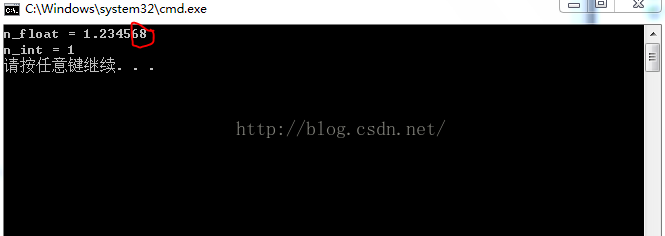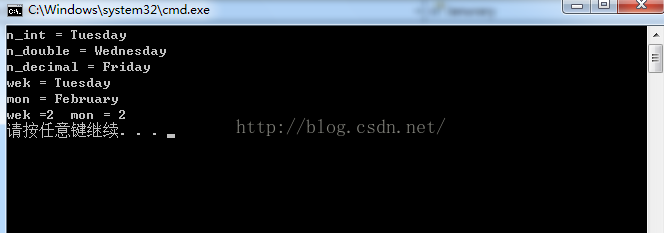집 >백엔드 개발 >C#.Net 튜토리얼 >C# 학습 일기 17---유형 변환의 구체적인 사용 사례 보기
C# 학습 일기 17---유형 변환의 구체적인 사용 사례 보기
- 黄舟원래의
- 2017-01-21 15:07:061698검색
C#의 유형 변환에는 이전 글에서 소개한 암시적 유형 변환 외에도 선언해야 하는 유형 변환------명시적 유형 변환이 있습니다.
Explicit 유형 변환(강제 유형 변환이라고도 함)은 변환을 수행할 때 변환 유형을 명시적으로 지정해야 합니다. 예를 들어, long 유형을 int 유형으로 변환하는 경우 이 변환은 정밀도를 잃는 변환이므로 시스템은 이를 수행하지 않습니다. 자동으로 암시적 변환을 수행하므로 강제 변환이 필요합니다:
long l = 6000;
int i = (int)l; //需要用在 ()里面声明转换类型다음과 같은 두 가지 유형에 대해서는 표시 유형 변환이 적용되지 않습니다.
int i = 6000;
string i = (string)i; //这里会报错따라서 표시 유형 변환에도 특정 사항이 있습니다. 규칙:
숫자 변환 표시
열거 변환 표시
-
참조 변환 표시;
디스플레이 변환이 항상 성공하는 것은 아니며, 종종 정보의 손실이 발생할 수 있습니다(종류가 다르기 때문에 범위와 정밀도도 다릅니다. 자세한 내용은 데이터를 참조하세요) 유형) 표시 변환에는 모든 암시적 변환이 포함됩니다. 따라서 암시적 변환은 다음과 같이 명시적 변환 형식으로 작성할 수도 있습니다.
int i = 6000;
long l = (long)i; //等价于 long l = i;표시 숫자 변환:
표시 숫자 변환을 참조합니다. 다음과 같이 값 유형과 값 유형 간의 변환 규칙:
sbyte에서 byte, ushort, uint, ulong, char 유형
바이트에서 sbyte, char 유형;
short에서 sbyte, byte, ushort, uint, ulong, char 유형
에서 ushort에서 sbyte, byte, short, char 유형으로 ;
int에서 sbyte로, byte, short, ushort, uint, ulong, char 유형
-
uint에서 sbyte, byte, short, ushort, int, char 유형
long에서 sbyte, byte, short, ushort, int, uint, ulong, char 유형으로; ;
-
ulong에서 sbyte, byte, short, ushort, int, uint, long, char 유형
char에서 sbyte로, byte, short 유형
-
float에서 sbyte, byte, short, ushort, int, uint, long, ulong, char,decimal 유형으로;
double에서 sbyte, byte, short, ushort, int, uint, long, ulong, float, char, 십진수 유형 - 십진수에서 sbyte, byte, short, ushort, int, uint, long, ulong, float, char, double type;
- 이렇게 많이 작성한 후에 요약하자면 고정밀도에서 저정밀도로의 변환일 수도 있습니다. 보존 변환 또는 반올림 변환으로 작성해 보겠습니다. 예:
using System;
using System.Collections.Generic;
using System.Linq;
using System.Text;
namespace Test
{
class Program
{
static void Main(string[] args)
{
double n_double = 1.73456789;
float n_float = (float)n_double; //显示转换 float的有效为只有8位(.也是一位)所以从第9位四舍五入
int n_int = (int)n_double; //只保留整数
Console.WriteLine("n_float = {0}\nn_int = {1}",n_float,n_int);
}
}
} 실행 결과:
double 데이터 범위가 float의 유효한 값 범위를 초과하면 표시됩니다. 변환 시 9번째 자리는 반올림되고, int형으로 변환 시 정수 부분만 남게 됩니다. 
- 모든 열거 유형에서 sbyte, byte, short, ushort, int, uint로 변환 , long, ulong, float, char, double, 10진수 유형
- 모든 열거형에서 다른 열거형으로
- 작성합니다. 예:
using System;
using System.Collections.Generic;
using System.Linq;
using System.Text;
namespace Test
{
class Program
{
enum weekday //定义2个枚举
{Sunday,Monday,Tuesday,Wednesday,Thursday,Friday,Saturday }
enum Month
{Janurary=1,February,March,April,May,Jun,July }
static void Main(string[] args)
{
int n_int = 2;
double n_double = 3.0;
decimal n_decimal = 5m; //声明decimal 类型要加m
weekday weki = (weekday)n_int; //从int、double、decimal到枚举转换
weekday wekd = (weekday)n_double;
weekday wekde = (weekday)n_decimal;
weekday wek = weekday.Tuesday; //枚举类型之间的转换
Month mon = (Month)wek;
int i = (int)wek; //从枚举类型到int的转换
int t = (int)mon;
Console.WriteLine("n_int = {0}\nn_double = {1}\nn_decimal = {2}",weki,wekd,wekde);
Console.WriteLine("wek = {0}\nmon = {1}\nwek ={2}\tmon = {3}",wek,mon,i,t);
}
}
}실행 결과:
참조 변환 표시: 
using System;
using System.Collections.Generic;
using System.Linq;
using System.Text;
namespace Test
{
class Program
{
//定义2个类 teacher与man
class teacher
{ }
class man
{ }
static void Main(string[] args)
{
man per = new man(); //将man实例化一个对象per
object o = per; //装箱
teacher p = (teacher)o; // 将o显示转换为teacher类
}
}
} 클래스 유형 s에서 클래스 유형 t로 변환(여기서 s는 t의 기본 클래스입니다. using System;
using System.Collections.Generic;
using System.Linq;
using System.Text;
namespace Test
{
class Program
{
class man //定义一个基类
{ }
class student:man //student继承man
{ }
static void Main(string[] args)
{
man per = new man(); //man实例化一个对象per
student stu = (student)per; //将父类转换为子类
}
}
} 클래스 유형 s에서 인터페이스 t로 변환, 여기서 s는 밀봉되지 않음). 인터페이스에 대해서는 나중에 쓰겠습니다. 메서드 선언만 하고 메서드를 정의하지는 않습니다.) using System;using System.Collections.Generic;
using System.Linq;using System .Text;
namespace Test
{
class Program
{
public interface teacher //定义一个接口
{ }
class student //定义一个类
{ }
static void Main(string[] args)
{
student stu = new student(); //实例化一个对象
teacher tea = (teacher)stu; // 显示转换
}
}
}인터페이스 유형 s에서 클래스 유형 t로 변환. 여기서 t는 봉인된 클래스가 아니며 s를 구현하지 않습니다.
using System;
using System.Collections.Generic;
using System.Linq;
using System.Text;
namespace Test
{
class Program
{
public interface man //定义一个接口
{ }
class teacher:man //定义一个继承于man的类man
{ }
class student //定义一个新类
{ }
static void Main(string[] args)
{
man teac=new teacher(); //间接实例化一个接口
student stu = (student)teac; // 显示转换
}
}
}인터페이스 유형에서 변환 s를 인터페이스 유형 t로, 여기서 s는 t의 하위 인터페이스가 아닙니다.using System;
using System.Collections.Generic;
using System.Linq;
using System.Text;
namespace Test
{
class Program
{
public interface man //定义一个接口
{ }
class teacher : man //由接口派生一个类
{ }
public interface person //定义一个接口
{ }
class student:person //由接口派生一个类
{ }
static void Main(string[] args)
{
man teac=new teacher(); //间接实例化一个接口
person stu = (person)teac; // 显示转换
}
}
}참조 유형 배열 및 참조 유형 배열 표시 변환, 여기서 둘은 상위 클래스 및 하위 클래스입니다. 관계(차원은 다음과 같아야 함) 동일)using System;
using System.Collections.Generic;
using System.Linq;
using System.Text;
namespace Test
{
class Program
{
class teacher
{ }
class student:teacher //studnet继承teacher
{ }
static void Main(string[] args)
{
teacher[] teac = new teacher[5];
student[] stu = new student[5];
stu = (student[])teac; //显示转换
}
}
} 다음 배열로 변경하면 작동하지 않습니다using System;
using System.Collections.Generic;
using System.Linq;
using System.Text;
namespace Test
{
class Program
{
static void Main(string[] args)
{
double[] n_double = new double[5];
float[] n_float = new float[5];
n_float = (float[])n_double; //这里出错啦
}
}
}System.Array에서 배열 유형으로(array는 모든 배열 유형의 기본 클래스입니다)
using System;
using System.Collections.Generic;
using System.Linq;
using System.Text;
namespace Test
{
class Program
{
static void Main(string[] args)
{
Array arr = new Array[5]; //定义一个Array类型的数组并初始化
double[] d = new double[5];
d = (double[])arr; //显示转换
}
}
}System.Delegate에서 대표(delegate)형으로using System;
using System.Collections.Generic;
using System.Linq;
using System.Text;
namespace Test
{
class Program
{
public static delegate int mydele(); //声明一个委托
class DE : Delegate //定义一个继承于Delegate 的类DE
{ }
static void Main(string[] args)
{
Delegate MY =new DE(); // 将Delegate 抽象类间接实例化
mydele my = (mydele)MY; //显示转换
}
}
}위는 C# 학습일지 17의 내용입니다---형 변환의 구체적인 사용 사례를 표시하고 있으니, 더 많은 관련 내용을 참고해주세요. PHP 중국어 홈페이지(www.php.cn)로!

